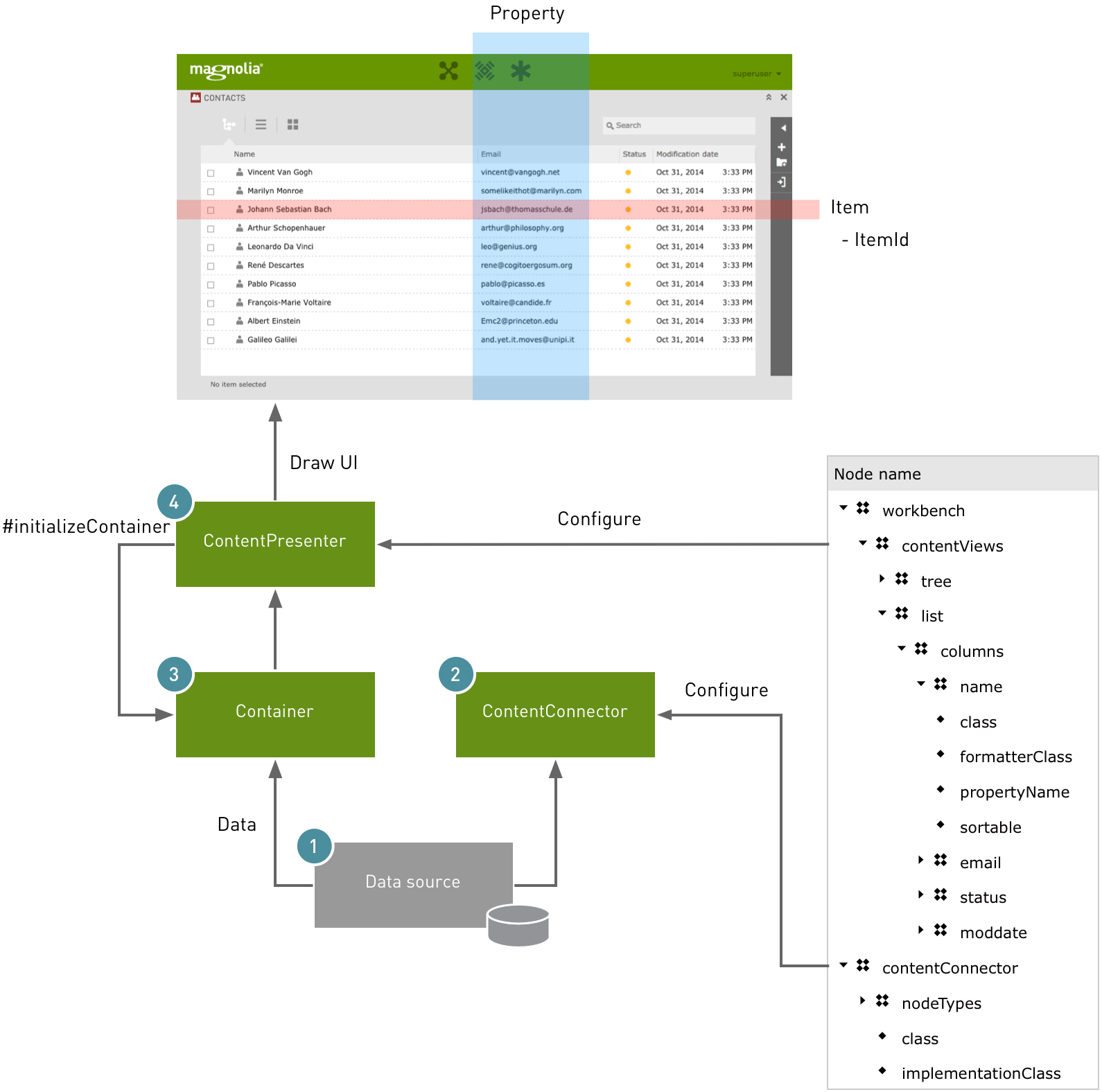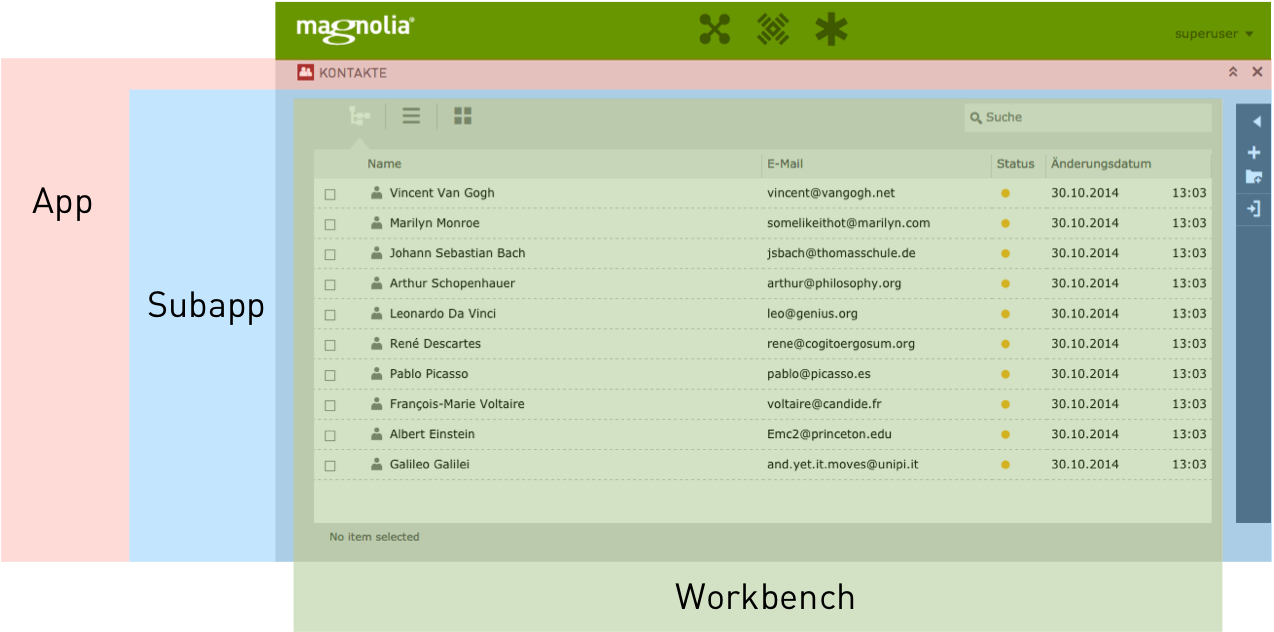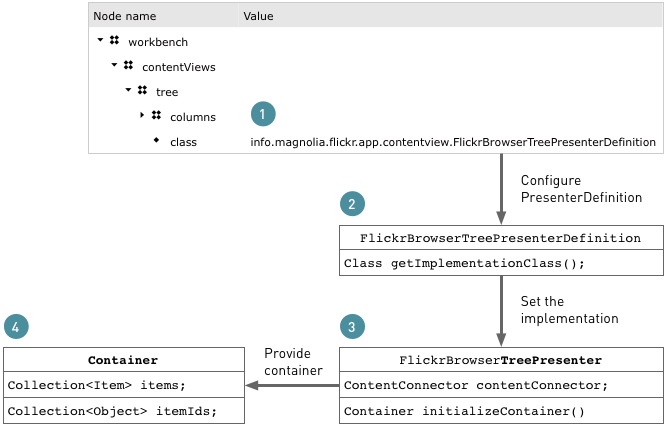Content app framework - 5 UI
Deprecated
|
This content app framework is based on the deprecated Vaadin 7, which has been replaced with Vaadin 8 since Magnolia 6.0. It is part of the Magnolia 5 UI framework. For Vaadin 8 data binding, see Data source definition and Item providers instead. |
On this page, we explain the building blocks of the content app framework and provide some guidelines.
Building blocks
This diagram shows the building blocks you need to create a custom content app:
-
Data source contains the data such as products.
-
ContentConnectoris a bridge to the data source. It helps you read content from data sources outside the JCR repository. -
Containerrepresents the data source in a Vaadin context. It provides methods to get, add and remove items and properties. -
ContentPresenteruses the data in theContainerto draw a user interface.

Container, ItemIds and Items
We start with some Vaadin basics which you should know. We recommend to read Vaadin documentation for general information about Container and binding components to Data.
A Container represents a data source in a Vaadin context. The Container provides methods to get, add and remove items and properties in the data source. The Container can hold 0 to n items. An Item can hold 0 to n Properties. The Presenter uses the data of a Container to render a Content view.

-
Container wraps the data of the data source. It provides methods to get items by their ID, to get all Items, to get all itemIds and so on. Every Container must implement at least the Container interface.
-
ItemIdis the key to get an item. Vaadin doesn’t type theItemId. It is just an object. A simpleItemIdcould be a string. In some cases, anItemIdis a POJO with its own properties (for example,JcrItemId).ItemIdsare sent by events. -
Itemis comparable to a row in a database table; it must implement the Vaadin Item interface. An item contains a set of properties and offers methods to add, modify and remove the properties.
Every property is identified by a property ID. The property ID is not typed either, it is just an object, usually a string. Use the property ID to configure columns in the content view. -
Property is the Vaadin interface for a item property. A property has a value and a type.
You must configure the Container before adding items: The Container must know the properties (IDs and types) which it will display. You can add an item only, if all of its properties are known to the Container. It is valid to add an item which has not all properties as the configured Container.
Guidelines for creating Containers
-
Write methods of the Container interface are not required when running in the content app.
-
If you want to manipulate data - add, edit, delete - do not manipulate
Containeritems. Instead, create actions that interact directly with the data source. After an action is executed, the view and its underlyingContainerare refreshed automatically if theContainerimplementsRefreshable. -
Create a fully customized
Containeror extend a concrete implementation provided by Vaadin or Magnolia. -
When creating a fully custom
Container, implementemptywrite methods (not required).@Override public Object addItem() throws UnsupportedOperationException { throw new UnsupportedOperationException("addItem is not supported!"); }
Mandatory and optional Container interfaces
In addition to the base interface Container there are a number of subinterfaces. Which of them should a custom Container implement?
-
The
Containerinterface is mandatory. -
A Container of a tree view additionally requires at least Container.Hierarchical. Implementing Collapsible is not mandatory but helpful in a custom tree Container.
-
For lazy loading behavior implement also Container.Indexed.
-
Implementing
Refreshableis optional but recommended.
Concrete Vaadin Containers
Vaadin offers some concrete Containers. Use IndexedContainer for a list and HierarchicalContainer for a tree. The hierarchical Container extends the list. Both extend AbstractInMemoryContainer.
To prepare a concrete Vaadin Container within a content subapp, create the data structure using the Container’s write methods to add the data which goes into memory.
Concrete Vaadin Containers are difficult to use for lazy loading. If you find a nice lazy loading solution in a subclass of HierarchicalContainer, please leave a comment!
Guidelines for ItemIds
The Vaadin API leaves it open how you want to implement ItemIds. In the
Vaadin API an ItemId is just an Object. Think carefully what ItemId to
use.
-
An ItemId must be unique within a Container.
-
The itemId must carry enough information to fetch data from the data source to instantiate its corresponding Item. This is required in the context of
ContentConnector. For example,JcrItemIdis a plain Java object that carries two properties:uuidandworkspace. These two properties are sufficient to get data from a JCR repository given that there is access to Session. -
It must be possible to get
ItemIdof a given item in the context ofContentConnector.
What is a good ItemId? String or POJO?
A String is a very simple and easy implementation for an ItemId. If your data source provides a unique String which is sufficient to build the corresponding item by querying the data source using only the String, then a String as ItemId is fine. However, if you must concatenate a String to build a unique itemId you should rather implement a plain Java object (POJO) for the ItemId.
When using a POJO you will require a method which creates a String representation of your ItemId. Furthermore it must be possible to create an ItemId (of your type, the POJO) by the String representation.
Creating Items
When using a concrete Container from Vaadin, you won’t need a specific Item implementation, instead you have to add items by calling:
Item item = addItem(Object itemId);which returns an Item on which you have to set properties.
|
Tip: When using a Container which extends
IndexedContainer,
Items returned by |
When you implement a fully customized Container you most probably require a custom Item. Extend a Vaadin implementation. BeanItem and PropertysetItem are both adequate for many use cases.
Content view Presenter knows columns and provides a Container
A Magnolia content app contains at least one subapp, displayed to users as a tab. A browser subapp is a special type of subapp that contains a workbench for operating on content items.

The workbench must have at least one content view. Magnolia provides three view types out of the box: tree, list and thumbnail. You can also define other customized views.
To add a content view you need at least:
-
ContentPresenterimplementation -
ConfiguredContentPresenterDefinitionimplementation
A content view is rendered by the content presenter which must be configured separately for each view. The data rendered on the view is provided by the Container. The presenter instantiates a suitable Container.
A tree view requires a Container which implements the Container.Hierarchical interface. For list and thumbnail views it is sufficient to have a Container which implements only the base interface Container.
This means that you will probably need different Containers for different views.
The subapp has exactly one ContentConnector which must work for all used Containers within the sub-app.
Content view configuration
A content view configuration requires the following parts:
-
ContentPresenterfor every content view in a content app.-
classproperty -
columnsnode for configuring columns
-
-
ContentPresenterDefinitionto set the implementation class of the custom content presenter. -
ContentPresenterthat extendsAbstractContentPresenterBaseor one of its subclasses. Connected to a Container. Must implement theAbstractContentPresenterBase#initializeContainermethod. -
Container that is bound to the content presenter.

Column configuration
Every column in the view must be configured. Example:
JCR node YAML
| Node name | Value |
|---|---|
contentViews |
|
columns# |
|
title# |
|
class# |
info.magnolia.flickr.app.contentview.FlickrBrowserItemColumnDefinition |
formatterClass# |
info.magnolia.flickr.app.contentview.FlickrBrowserItemColumnFormatter |
propertyName# |
title |
contentViews:
columns:
- name: title
class: info.magnolia.flickr.app.contentview.FlickrBrowserItemColumnDefinition
formatterClass: info.magnolia.flickr.app.contentview.FlickrBrowserItemColumnFormatter
propertyName: title| Property | Description |
|---|---|
|
required The name of a column is arbitrary, however, it makes sense to use the
same or similar name as the |
|
required A definition class that must extend |
|
required A formatter class that must extend |
|
required Must be equal to a Container property ID. |
For all properties, see Column definition.
ContentConnector knows the relation between item, itemId and URL fragment
ContentConnector is a core piece for a content app. It knows which item belongs to an itemId and vice versa. The connector can create a URL fragment from an itemId and vice versa.
URL fragments and events
When the user selects an item in a content app, SelectionChangedEvent is fired.
The event carries the ID of the selected item. The event leads to a change in the BrowserLocation
object of the subapp. That’s why the URL fragment methods are required.
ContentConnector methods
If you look at the Container interface, its methods are similar to methods in the ContentConnector:
info.magnolia.ui.vaadin.integration.contentconnector.ContentConnector
public interface ContentConnector {
String getItemUrlFragment(Object itemId);
Object getItemIdByUrlFragment(String urlFragment);
Object getDefaultItemId();
Item getItem(Object itemId);
Object getItemId(Item item);
boolean canHandleItem(Object itemId);
}ContentConnector’s relation to Container
A ContentConnector must implement methods that are very similar to methods in the Container. That said, it can be handy to have an instance of the Container in your ContentConnector. However, as soon as you have more than one Container this pattern no longer works.
The presenter responsible for a view must initialize the Container. If
you can use one Container for all presenters, it is fine to couple
the ContentConnector with the Container. For example, if a subapp uses a
list view and a thumbnail view it should be possible to use the same
Container.
If you need more than one Container within a sub app, do not use Container in the ContentConnector implementation but get data directly from your data source the same way you retrieve data when preparing data for the Container.
You may implement a utility class which provides access to the data source and creates ItemIds and Items to use both in Container and contentConnector.
Best practice
Make the Container instance available in your ContentConnector. This makes it easier to implement item and itemId related methods. This works only if you have only one Container per subapp. If you need more Containers you must decouple the Container and the ContentConnector.
Configure and register a ContentConnector
Every subapp must provide and configure and register its own ContentConnector. Once registered, you can get the ContentConnector via injection.
-
Implement
ContentConnector. -
Create an interface that extends
ContentConnectorDefinition(for example,FlickrBrowserContentConnectorDefinition). -
Create a class that implements your interface and extends
ConfiguredContentConnectorDefinition. Set the implementation class. -
Configure the connector in the subapp:
<subapp>: contentConnector: class: info.magnolia.flickr.app.contentconnector.FlickrBrowserContentConnectorDefinition
Injecting the ContentConnector
ContentConnectorProvider creates one instance of the type of connector you set in
ConfiguredContentConnectorDefinition. You can inject your
ContentConnector into different classes wherever it is required. You
will always get the same instance.
Example:
public class FlickrBrowserTreePresenter extends TreePresenter {
private FlickrBrowserContentConnector contentConnector;
@Inject
public FlickrBrowserTreePresenter(TreeView view, ComponentProvider componentProvider, ContentConnector contentConnector) {
super(view, componentProvider);
this.contentConnector = (FlickrBrowserContentConnector) contentConnector;
}
}|
Since your subapp implementation class is either |